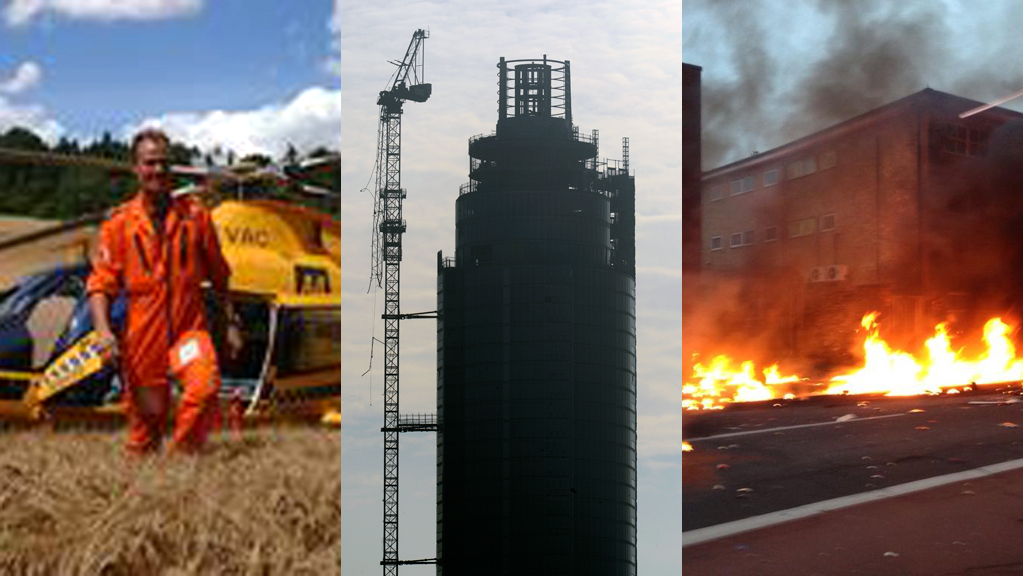Workmen stunned by lucky escape from helicopter crash
Two men who overslept when they should have been up a crane say they had a lucky escape. But is more regulation needed to protect against fatal crane-related accidents? Channel 4 News reports.

Richard Moule and Nicki Biagioni were late for work and hurrying to get up the crane in Vauxhall when a helicopter crashed into the structure and plunged over 200 metres to the ground.
Two men were killed in the crash: the pilot Pete Barnes [pictured], and a second man who was named by Scotland Yard as Matthew Wood, 39, from Sutton, south London. He is believed to have been walking to work when he was killed.
Twelve other people were injured and police said it was a “miracle” more were not hurt when the helicopter fell to the busy rush-hour streets.
An investigation is now underway to find out what caused the crash, with the findings expected in a few months time. Eyewitnesses said the helicopter appeared to spin out of control before the crash, but misty weather conditions were also named as a factor.
The crash happened at 8am on Wednesday near Vauxhall Station when the helicopter on a commercial scheduled flight hit a high-rise crane at The Tower, One St George Wharf, one of Europe’s largest skyscrapers.
Video report: Two dead after ‘horrendous’ helicopter crash
Lighting ‘not for night time’
Constructions over 150 metres from the ground such as the crane on the St George Tower are required to have lighting, and two notice to airman (NOTAMs) were in place to alert passing aircraft to its presence.
But the rules on required lighting are not designed for foggy conditions, a Civil Aviation Authority spokesperson told Channel 4 News.
“We had been in contact with architects at the site last October, and had told them of the need to have a light on the top,” he said. “But that lighting is designed for night time flying. The idea is that pilots can see what they’re flying towards and should avoid conditions where there wouldn’t be able to see what’s in front of them.”
Since 1990, nine people have died as result of crane accidents, and now two more since Wednesday. There have also been 60 accidents and 25 serious injuries, according to the health and safety executive, most of which were in London.
Mr Moule, 31, a father of two from Harlow, Essex, was supposed to be at work at 7am with his colleague Mr Biagioni, 30, but both were running late. “It was the first time I’ve been late since starting this job three years ago. I just woke up late. Call it divine intervention if you like,” Mr Moule told the Daily Mail.
He said he was in the building’s basement ready to go up when the accident happened and he was evacuated. “The first thing I did was call my wife Stephanie and tell her, ‘You’ll be hearing about this but I’m OK’,” he addded.
The company responsible for the construction site, Berkeley Group, told Channel 4 News that even if Mr Biagioni and Mr Moule were on time, health and safety requirements meant they would not have been allowed on the crane.
Not a ‘freak accident’
However campaigners say there is not enough regulation in place to guard against injury of the operators, and general public, when using cranes.
A crane safety register was established in 2010, requiring operators to record every time a crane is due to be used and have a safety plan in place. But the register was scrapped under the coalition government.
“After regulation was brought in in 2010, there were no accidents until now,” Tony O’Brien from the construction safety campaign told Channel 4 News. “That registration [would have] meant that [at] Vauxhall you would have had a closer pair of eyes on what they were doing.”
“People from our campaign had complained about poor lighting on the crane,” he added. “It’s a leathal weapon – a crane, up in the sky. It’s not a freak accident.”